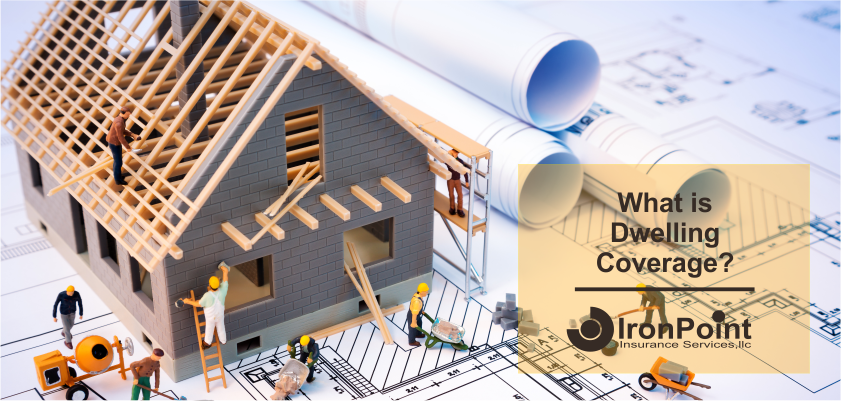What is Dwelling Coverage? (The One Part of Your Homeowners Policy You Can’t Afford to Ignore)

Let’s be honest. Reading your homeowner’s insurance policy—especially the dwelling coverage section—ranks somewhere between watching paint dry and alphabetizing your spice rack on the excitement scale. But here’s the truth no insurance agent wants to admit: most people don’t understand dwelling coverage, the very thing they’re paying thousands to protect each year.
And that’s exactly why we need to talk about it.
While most people nod and smile when their agent mentions “Coverage A,” inside they’re thinking, “I’ll just Google that later.” Well, congratulations – your “later” has arrived.
The $300,000 Question: What Exactly IS Dwelling Coverage?
Dwelling coverage is the backbone of your entire homeowner’s policy – the foundation upon which all your other home insurance coverages are built. Without it, you’re basically asking Mother Nature to play nice with your largest investment.
Good luck with that strategy.
In plain English, dwelling coverage protects the physical structure of your home – the walls that keep the weather out, the roof over your head, and the foundation keeping everything from sinking into the earth. It’s the part of your policy that rebuilds your house when disaster strikes.
And let’s face it – disasters rarely RSVP before they arrive.
Breaking Down “Dwelling” (Because Insurance Companies Can’t Use Normal Words)
Insurance companies seem pathologically incapable of using everyday language. They could just say “your house,” but instead, they insist on “dwelling.” Why? Perhaps it makes them feel more sophisticated at cocktail parties.
But here’s what they actually mean:
Your dwelling includes:
- The physical structure of your home
- The roof (yes, that expensive thing you hope lasts 30 years)
- Your foundation (the part you never see but desperately need)
- Attached structures (like that garage you’ve been meaning to clean out for three years)
- Built-in appliances
- Electrical systems, plumbing, and HVAC
In the hierarchy of insurance importance, dwelling coverage is the queen bee. It’s typically the most expensive component to replace, and it determines the limits for several other coverages on your policy.
Get The FREE Home Insurance Review Checklist
Quickly identify coverage gaps and strengthen your insurance protection with our easy and FREE Home Insurance Review Checklist.
What Dwelling Coverage Actually Protects You Against (And What It Sneakily Doesn’t)
Here’s where things get interesting. Your dwelling coverage doesn’t protect against “everything bad that could happen.” Instead, it covers specific perils – insurance-speak for “disasters we’ve decided to acknowledge.”
What’s Typically Covered:
- Fire and smoke damage (including that time you tried to make flambé)
- Lightning strikes (nature’s way of saying you’re special)
- Windstorms and hail (because Mother Nature likes to throw things)
- Falling objects (like that tree you’ve been meaning to trim)
- Vandalism (when someone decides your home needs unwanted “improvements”)
- Damage from the weight of ice, snow, or sleet (winter’s parting gift)
- Sudden and accidental water damage (not the slow leak you ignored)
- Explosions (hopefully something you’ll never experience)
- Damage from vehicles (including your teenager’s driving lessons)
What’s Conspicuously NOT Covered:
- Floods (water from the ground up or outside in)
- Earthquakes (the earth’s occasional temper tantrums)
- Normal wear and tear (sorry, that’s called “homeownership”)
- Neglect (you can’t ignore problems and expect insurance to fix them)
- Sewer backups (as disgusting as they are expensive)
- Insect or vermin damage (termites laugh at your insurance policy)
The insurance industry’s blind spot? These exclusions are where most homeowners get caught with their financial pants down. That’s why supplemental policies like flood insurance exist – to fill the gaps the standard policy conveniently leaves open.
Unattached Structures: The Forgotten Cousins of Dwelling Coverage
That shed where you store your holiday decorations? The detached garage housing your “someday” project car? The fence keeping your neighbor’s questionable landscaping choices at bay?
None of these fall under dwelling coverage.
Instead, they’re covered by the aptly named “Other Structures” coverage – typically calculated as 10% of your dwelling amount. So, if your home is insured for $400,000, you’d have about $40,000 to rebuild your detached structures.
Which seemed like plenty until you realized your custom workshop/man cave/she-shed cost $30,000 to build five years ago.
The Million-Dollar Question: How Much Dwelling Coverage Do You Actually Need?
Here’s where most homeowners make a critical mistake. They insure their home for its market value or, worse, the mortgage amount.
Both approaches are dangerously wrong.
Your dwelling coverage should reflect the cost to rebuild your home from scratch — which has absolutely nothing to do with your local real estate market or remaining loan balance.
Rebuilding costs include:
- Current construction labor rates in your area
- Building materials (which, as we’ve all noticed, aren’t getting cheaper)
- Architectural and engineering fees
- Permits and inspections
- Debris removal
- Code compliance upgrades (surprise!)
Many insurance companies use sophisticated calculators to estimate these costs, but here’s a pro tip: these algorithms aren’t perfect. If you have a unique home or custom features, consider getting an independent appraisal to determine accurate replacement cost.
Deductibles: The Price of Admission to Your Coverage
Your property deductible is essentially the co-pay of the insurance world – the amount you’ll pay before your insurance company opens their wallet.
Conventional wisdom says to choose the highest deductible you can afford to lower your premiums. But this advice misses an important psychological factor: if your deductible is too high, you might avoid making legitimate claims altogether.
The sweet spot? A deductible that’s:
- High enough to discourage filing minor claims (which can raise your rates)
- Low enough that you could comfortably pay it tomorrow if disaster struck
For most homeowners, that lands somewhere between $1,000 and $2,500.
Get The FREE Home Insurance Review Checklist
Quickly identify coverage gaps and strengthen your insurance protection with our easy and FREE Home Insurance Review Checklist.
The Bottom Line: Dwelling Coverage Isn’t Optional
In a world where cutting costs has become a competitive sport, dwelling coverage isn’t the place to skimp. It’s the foundation of your entire homeowner’s policy – the part that rebuilds your home when life goes sideways.
Every year, thousands of homeowners discover they’re underinsured when it’s already too late. Don’t join their ranks.
Review your dwelling coverage annually. Ask hard questions. Push back if the numbers don’t make sense. Remember: insurance is the product you buy hoping never to use, which makes it all too easy to ignore until you need it.
And when you need it, you really need it.
Want to make sure your dwelling coverage is actually protecting your home? Give us a call, or start a quote online. We’ll help translate insurance-speak into English and ensure your biggest investment isn’t your biggest vulnerability.
Remember: The best insurance policy is the one that’s there when you need it – not the one that leaves you explaining to your family why half your house won’t be rebuilt.
Let’s Get Started
Select the way you want to start your quote.







